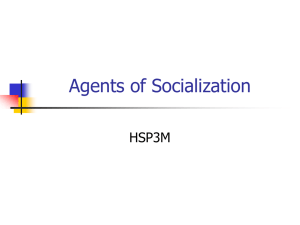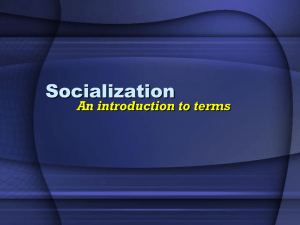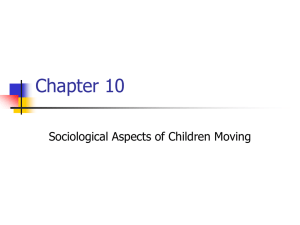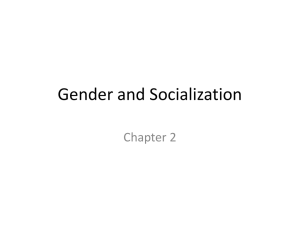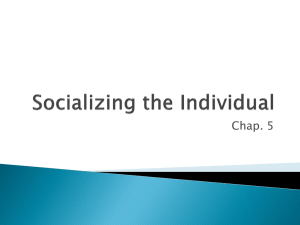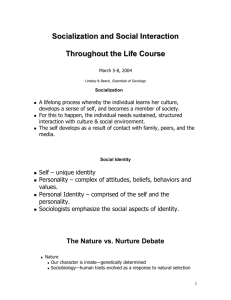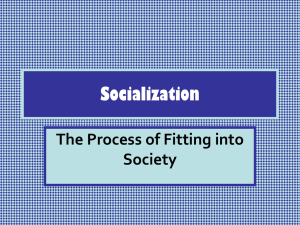Socialization
advertisement
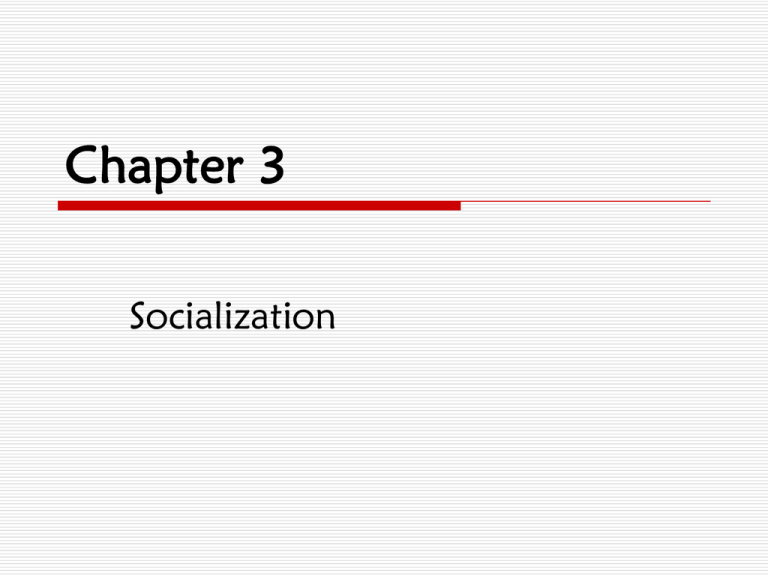
Chapter 3 Socialization Socialization The lifelong process of social interaction through which individuals acquire a self identity and the physical, mental, and social skills needed for survival in society. Socialization is the essential link between the individual and society. Why Socialization Is Important Teaches us ways to think, talk and act that are necessary for social living. Ensures that members of society are socialized to support the existing social structure. Allows society to pass culture on to the next generation. How Much Do You Know About Early Socialization and Child Care? True or False ? The average annual salary of a child-care worker is less than the average yearly salaries for funeral attendants or garbage collectors. How Much Do You Know About Early Socialization and Child Care? True. The average salary for a child-care worker is only $15,430 per year, which is less than the yearly salaries for people in many other employment categories. How Much Do You Know About Early Socialization and Child Care? True or False? After-school programs have greatly reduced the number of children who are home alone after school. How Much Do You Know About Early Socialization and Child Care? False. Although after-school programs have slightly reduced the number of children at home alone after school, nearly seven million school-age children are alone each week while their parents work. Human Development Each of us is a product of two forces: 1. Heredity- “nature” • Determines our physical makeup. 2. Social environment -“nurture.” • Determines how we develop and behave. Freud’s Theory of Personality Freud’s Theory of Personality Human development occurs in three states that reflect different levels of personality: Id Ego Superego Piaget’s Stages of Cognitive Development 1. Sensorimotor stage (birth to age 2) children understand the world through sensory contact and immediate action. 2. Preoperational stage (age 2 to 7) children begin to use words as symbols and form mental images. Piaget’s Stages of Cognitive Development 3. Concrete operational stage (7 to 11) children think in terms of tangible objects and events. 4. Formal operational stage (12 and up) - adolescents begin to think about the future and evaluate different courses of action. Kohlberg’s Stages of Moral Reasoning 1. Preconventional level (7 to 10) Children’s perceptions are based on punishment and obedience. 2. Conventional level (10 to adult) People are concerned with how they are perceived by peers and how one conforms to rules. Kohlberg’s Stages of Moral Reasoning 3. Postconventional level (few adults reach this stage) People view morality in terms of individual rights; “moral conduct” is judged by principles based on human rights that transcend government and laws. Gilligan’s Stages of Female Moral Development Stage 1: A woman is motivated primarily by selfish concerns. Stage 2: She recognizes her responsibility to others. Stage 3: She makes a decision based on a desire to do the greatest good for self and for others. The Looking-Glass Self 1. We imagine how we look to others. 2. We imagine how other people judge the appearance that we think we present. • • If we think the evaluation is favorable our self-concept is enhanced. If we think the evaluation is unfavorable, our self-concept is diminished. The Looking-Glass Self Mead and Role-taking The self is divided into “I” and “Me”: “I” represents the unique traits of each person. “Me” is composed of the demands of others and the awareness of those demands. “I” develops first. “Me” is formed during three stages of self development. Mead’s Three Stages of Self-Development 1. Preparatory Stage (up to age 3) Children prepare for role-taking by imitating the people around them. 2. Play Stage (3 - 5) Children begin to see themselves in relation to others. Mead’s Three Stages of Self-Development 3. Game Stage (early school years) Children understand their social position and the positions of those around them. Children become concerned about the demands and expectations of others. Agents of Socialization Family Peer Group School Mass Media Polling Question Which agent of socialization do you think is the most responsible for gender differences in how males and females are socialized? A. B. C. D. E. The family Religion The peer group Education Mass media Functionalist Perspective: Functions of Schools Teach students to be productive members of society. Transmit culture. Social control and personal development. Select, train, and place individuals on different rungs in society. Conflict Perspective: Schools Experiences depend on social class, racial–ethnic background, gender, and other factors. Children learn to be neat, punctual, quiet, wait their turn, and remain attentive to their work. Schools socialize children for later roles in the work force. Media As Socializing Agents 1. Inform us about events. 2. Introduce us to a variety of people. 3. Provide an array of viewpoints on current issues. 4. Make us aware of products that will supposedly help us. 5. Entertain us. Polling Question Which media source do you think has the strongest impact on attitudes and behaviors of your generation? A. B. C. D. E. Advertising Television Music and music videos The Internet Magazines Quick Quiz 1. Socialization is essential for: A. the individual's survival and for human development. B. all of the choices. C. the survival and stability of society. D. society to learn how to reproduce itself. Answer: B Socialization is essential for the individual's survival and for human development, the survival and stability of society and for society to learn how to reproduce itself. 2. The lifelong practice of social interaction through which individuals acquire a self-identity and the physical, mental, and social skills needed for survival in society is called: A. B. C. D. socialization sociological imagination acculturation assimilation Answer: A The lifelong practice of social interaction through which individuals acquire a self-identity and the physical, mental, and social skills needed for survival in society is called socialization. 3. Kohlberg's research classified moral reasoning into three sequential levels as follows: A. B. C. D. id, ego, superego imagination, imitation, and simulation preparatory, play, game preconventional, conventional, postconventional Answer: D Kohlberg's research classified moral reasoning into three sequential levels as follows preconventional, conventional, postconventional. 4. The ________ by Charles Horton Cooley refers to the way in which a person's sense of self is derived from the perceptions of others. A. B. C. D. generalized other reference group self looking glass self ego Answer: C The looking glass self by Charles Horton Cooley refers to the way in which a person's sense of self is derived from the perceptions of others. 5. Agents of socialization include: A. B. C. D. mass media school all of the choices the family Answer: C Agents of socialization include the mass media, school, and the family.

